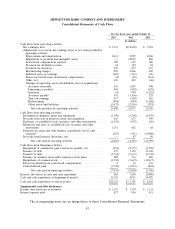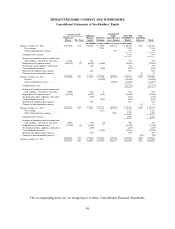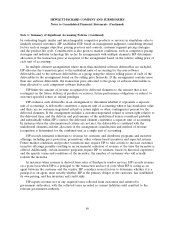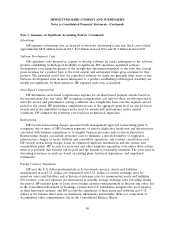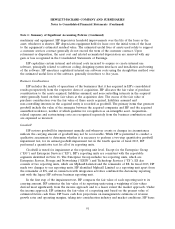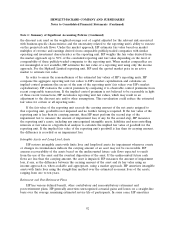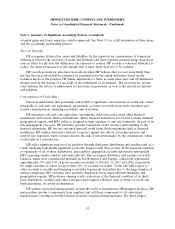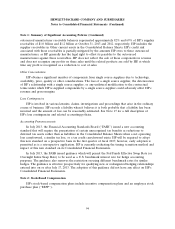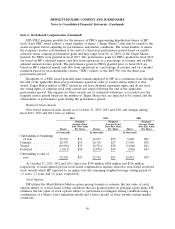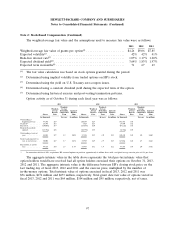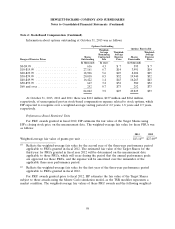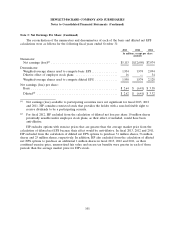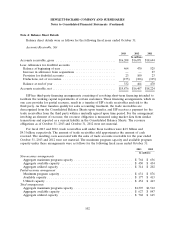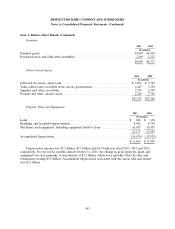HP 2013 Annual Report Download - page 101
Download and view the complete annual report
Please find page 101 of the 2013 HP annual report below. You can navigate through the pages in the report by either clicking on the pages listed below, or by using the keyword search tool below to find specific information within the annual report.HEWLETT-PACKARD COMPANY AND SUBSIDIARIES
Notes to Consolidated Financial Statements (Continued)
Note 1: Summary of Significant Accounting Policies (Continued)
actuarial gains and losses using the corridor approach. See Note 15 for a full description of these plans
and the accounting and funding policies.
Taxes on Earnings
HP recognizes deferred tax assets and liabilities for the expected tax consequences of temporary
differences between the tax bases of assets and liabilities and their reported amounts using enacted tax
rates in effect for the year the differences are expected to reverse. HP records a valuation allowance to
reduce the deferred tax assets to the amount that is more likely than not to be realized.
HP records accruals for uncertain tax positions when HP believes that it is not more likely than
not that the tax position will be sustained on examination by the taxing authorities based on the
technical merits of the position. HP makes adjustments to these accruals when facts and circumstances
change, such as the closing of a tax audit or the refinement of an estimate. The provision for income
taxes includes the effects of adjustments for uncertain tax positions, as well as the related net interest
and penalties.
Concentrations of Credit Risk
Financial instruments that potentially subject HP to significant concentrations of credit risk consist
principally of cash and cash equivalents, investments, accounts receivable from trade customers and
contract manufacturers, financing receivables and derivatives.
HP maintains cash and cash equivalents, investments, derivatives and certain other financial
instruments with various financial institutions. These financial institutions are located in many different
geographical regions, and HP’s policy is designed to limit exposure to any one institution. As part of its
risk management processes, HP performs periodic evaluations of the relative credit standing of the
financial institutions. HP has not sustained material credit losses from instruments held at financial
institutions. HP utilizes derivative contracts to protect against the effects of foreign currency and
interest rate exposures. Such contracts involve the risk of non-performance by the counterparty, which
could result in a material loss.
HP sells a significant portion of its products through third-party distributors and resellers and, as a
result, maintains individually significant receivable balances with these parties. If the financial condition
or operations of all of these distributors’ and resellers’ aggregated accounts deteriorate substantially,
HP’s operating results could be adversely affected. The ten largest distributor and reseller receivable
balances, which were concentrated primarily in North America and Europe, collectively represented
approximately 21% and 14% of gross accounts receivable at October 31, 2013 and 2012, respectively.
No single customer accounts for more than 10% of accounts receivable. Credit risk with respect to
other accounts receivable and financing receivables is generally diversified due to the large number of
entities comprising HP’s customer base and their dispersion across many different industries and
geographical regions. HP performs ongoing credit evaluations of the financial condition of its third-
party distributors, resellers and other customers and requires collateral, such as letters of credit and
bank guarantees, in certain circumstances.
HP utilizes outsourced manufacturers around the world to manufacture HP-designed products. HP
may purchase product components from suppliers and sell those components to its outsourced
manufacturers creating receivable balances from the outsourced manufacturers. The three largest
93


